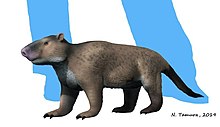Palaeanodonta
Appearance
| Palaeanodonts | |
|---|---|

| |
| Reconstruction of Metacheiromys marshi | |

| |
| Reconstruction of Ernanodon antelios | |
| Scientific classification | |
| Domain: | Eukaryota |
| Kingdom: | Animalia |
| Phylum: | Chordata |
| Class: | Mammalia |
| Clade: | Pholidotamorpha |
| Order: | †Palaeanodonta Matthew, 1918 |
| Genera and Families | |
| |
Palaeanodonta is an extinct clade of stem-pangolins. They were insectivorous, possibly fossorial, and lived from the Early Paleocene to Early Oligocene in North America, Europe and eastern Asia.[1][2][3]
Classification and phylogeny
Traditional classification
- Order: †Palaeanodonta (stem-pangolins)[1]
- Family: †Epoicotheriidae
- Family: †Escavadodontidae
- Family: †Metacheiromyidae
- Incertae sedis:
- Genus: †Amelotabes
- Genus: †Arcticanodon
- Genus: †Melaniella
Revised classification
- Order: †Palaeanodonta (stem-pangolins)[3]
- Genus: †Brachianodon
- Genus: †Metacheiromys
- Genus: †Mylanodon
- Genus: †Palaeanodon
- Genus: †Propalaeanodon
- Family: †Epoicotheriidae
- Family: †Escavadodontidae
- Suborder: †Ernanodonta
- Family: †Ernanodontidae
- Incertae sedis:
- Genus: †Amelotabes
- Genus: †Arcticanodon
- Genus: †Melaniella
Phylogenetic tree
The phylogenetic relationships of Palaeanodonta are shown in the following cladogram:[1][2][3]
| Pholidotamorpha |
| ||||||
(Pholidota sensu lato)
|
References
- ^ a b c Kenneth D. Rose (2008). "9 - Palaeanodonta and Pholidota". doi:10.1111/brv.12242.
{{cite journal}}: Cite journal requires|journal=(help) - ^ a b Gaudin, Timothy (2009). "The Phylogeny of Living and Extinct Pangolins (Mammalia, Pholidota) and Associated Taxa: A Morphology Based Analysis" (PDF). Journal of Mammalian Evolution. 16 (4). Heidelberg, Germany: Springer Science+Business Media: 235–305. doi:10.1007/s10914-009-9119-9.
- ^ a b c Kondrashov, Peter; Agadjanian, Alexandre K. (2012). "A nearly complete skeleton of Ernanodon (Mammalia, Palaeanodonta) from Mongolia: morphofunctional analysis". Journal of Vertebrate Paleontology. 32 (5): 983–1001. doi:10.1080/02724634.2012.694319. ISSN 0272-4634.
